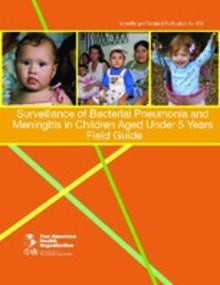Surveillance of bacterial pneumonia and meningitis in children aged under 5 years: Field Guide

|
This field guide was prepared by PAHO to support health workers participating in the epidemiological surveillance of bacterial pneumonia and meningitis. Pneumonia is among the leading causes of hospitalization and death for children aged under 5 years in the Region of the Americas. In developed countries, the majority of pneumonias are believed to be of viral origin; however, the etiology of pneumonia is almost always bacterial in developing countries. Bacterial meningitis, although not as frequent as pneumonia, is always a serious disease, given the risk of sequelae and its high case-fatality rate. Three bacteria are principally responsible for the diseases: Haemophilus influenzae (Hi) type b (Hib), Neisseria meningitidis (meningococcus), and Streptococcus pneumoniae (pneumococcus). The introduction of the Hib vaccine in countries of the Region produced a dramatic decline of invasive disease due to this bacterium, and pneumococcus is now the principal etiologic agent responsible for bacterial pneumonia and meningitis in children aged under 5 years. This first English language edition of the field guide was published in 2010. A second edition, in Spanish and in Portuguese, was published in 2020. |
